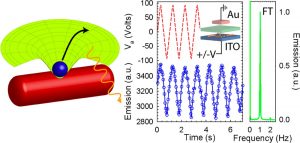Greg Hartland
With Greg Hartland in the Department we are working on both single particle infrared absorption measurements and on conducting transient absorption studies of individual semiconductor nanostructures. Visit website.

Representative papers
Ultrafast dynamics distributions within an ensemble: Transient absorption microscopy studies of single CdTe nanowires, S. S. Lo, T. A. Major, N. Petchsang, L. Huang, M. Kuno, G. V. Hartland, ACS Nano, 2012, 6, 5274.
Imaging and absolute extinction cross section measurements of nanorods and nanowires through polarization modulation microscopy, C. R. Carey, T. Lebel*, D. Crisostomo*, J. Giblin, M. Kuno, G. V. Hartland, J. Phys. Chem. C. 2010, 114, 16029.
Experimental determination of single NW absorption cross-sections through photothermal imaging, J. P. Giblin, S. Mohammad*, M. T. Banning*, M. Kuno, G. V. Hartland, ACS Nano 2010, 4, 358.
Ultrafast transient absorption measurements of charge carrier dynamics in single II-VI nanowires, C. R. Carey, Y. Yu, M. Kuno, G. V. Hartland, J. Phys. Chem. C 2009, 113, 19077.
Prashant Kamat
With Prashant Kamat we are working to better understand the limitations of hybrid perovskite solar cells. We have previously developed colloidal quantum dot solar cells and more recently nanowire-sensitized devices. Visit website.

Representative papers
A CdSe nanowire/quantum dot hybrid architecture for improving solar cell performance, Y. Yu, P. V. Kamat, M. Kuno, Adv. Funct. Mater. 2010, 20, 1464.
Quantum dot solar cells: tuning the photoresponse through size and shape control of CdSe-TiO2 architecture, A. Kongkanad, K. Tvrdy, K. Takechi, M. Kuno, P. V. Kamat, J. Am. Chem. Soc. 2008, 130, 4007.
Size-dependent electron injection from excited CdSe quantum dots into TiO2 nanoparticles, I. Robel, M. Kuno, P. V. Kamat, J. Am. Chem. Soc. 2007, 129, 4136.
Quantum dot solar cells. Harvesting light energy with CdSe nanocrystals molecularly linked to mesoscopic TiO2 films, I. Robel, R. Subramanian, M. Kuno, P. V. Kamat, J. Am. Chem. Soc. 2006, 128, 2385.
Boldizsar Janko
With Boldizsar Janko in physics we are exploring the origin of single particle fluorescence intermittency. This is a phenomenon ubiquitous at the single molecule level where the emission of individual molecules, fluorescent proteins, and quantum dots turns on and off in a seemingly random fashion. Despite having been discovered over 15 years ago, no consensus exists today as to the actual physical mechanism behind “blinking”. Our ultimate goal is to develop a microscopic picture that explains the unusual power law kinetics observed as well as the ubiquity of the phenomenon. Visit website.


Representative papers
Fluorescence intermittency originates from reclustering in two-dimensional organic semiconductors, A. Ruth, M. Hayashi, P. Zapol, J. Si, M. P. McDonald, Y. V. Morozov, M. Kuno, B. Janko, Nature Commun. 2017, 8, 14521.
Electric field-induced emission enhancement and modulation in individual CdSe nanowires, F. Vietmeyer, T. Tchelidze, V. Tsou, B. Janko, M. Kuno, ACS Nano, 2012, 6, 9133.
Universal emission intermittency in quantum dots, nanorods and nanowires, P. Frantsuzov, M. Kuno, B. Janko, R. A. Marcus, Nature Physics 2008, 4, 519.
